
The United Nations biodiversity summit is getting its moment in the sun. Traditionally overshadowed by the longer-running annual U.N. conference on climate change, the 16th edition of the biodiversity conference, or COP16, which launched Monday in Cali, Colombia, is expected to bring unprecedented attention to nature. It’s also an opportunity to ask how — and whether — we can change our food system to halt its rapid destruction.
This is a preview of Devex Dish
Sign up to this weekly newsletter to get the inside track on how agriculture, nutrition, sustainability, and more are intersecting to remake the global food system.
The pressure to feed a growing population is threatening biodiversity. The World Economic Forum estimates that agriculture and aquaculture threaten 54.5% of the more than 42,000 species currently at risk of extinction. Meanwhile, global wildlife numbers fell an average of 73% between 1970 and 2020 due to habitat loss and overharvesting, in large part due to the way we produce food, according to the World Wildlife Fund.
“The planet doesn't have time to lose," COP16 President and Colombian Environment Minister Susana Muhamad said at the opening meeting this week.
Meanwhile, conversations about reducing greenhouse gas emissions by encouraging a shift to plant-based diets are also taking place in the biodiversity space. In addition to creating outsized emissions, livestock require a lot of land — both to rear the animals and grow their food — which often gets carved out of forests and other biodiverse areas.
COP16 could offer an opportunity to build some momentum around these issues, but two key things need to happen, as Devex climate reporters Jesse Chase-Lubitz and Ayenat Mersie write.
The first is financing. COP15 in Montréal, Canada, in 2022 ended with the historic Kunming-Montreal Global Biodiversity Framework, or GBF, which included a commitment from wealthier countries to provide $20 billion per year by 2025 to restore biodiversity in low- and middle-income countries. Most have not lived up to their commitment. Of 28 countries that were tracked, 23 have paid less than half of their pledged amount, according to a report by the ODI think tank.
COP16 will need to jump-start those commitments, particularly in light of a goal to funnel $200 billion per year to conservation initiatives by 2030. There is a huge demand for the funding — not least to help poorer countries transition their food systems to minimize harm to biodiversity, while also ensuring that people have enough to eat.
In this same vein, the GBF also obligated signatories to draft action plans to address biodiversity loss and protection. But only 29 of the 196 participating countries had submitted their plans by Oct. 16. That included only five of the 17 countries that contain 70% of the world’s biodiversity. Poorer countries say they have some challenges with the obligations that the action plans might introduce, including calls to reduce the use of pesticides in the agricultural practices. COP16 will require some delicate conversations about how to balance biodiversity demands with the need to feed a rapidly growing population.
Getting those two efforts on track will be critical, but that’s not all to watch out for in Colombia. There are also important discussions around ensuring that countries and communities benefit when companies and researchers use digital sequences of their plants, animals, and microbes to advance fields like agriculture.
Read: Everything on the table at COP16 (Pro)
See also: Can quantifying nature via biodiversity credits be a way to save it?
+ Not yet a Devex Pro member? Start your 15-day free trial today to access all our expert analyses, insider insights, funding data, exclusive events, and more. Check out all the exclusive content available to you.
As a Pro member, you also get a $400 discount to attend Devex World, our flagship summit bringing together leaders and policymakers shaping the future of global development, happening tomorrow in Washington, D.C. Get your ticket now.
Lead by example
As the pressure mounts on governments to commit to their GBF plans in Colombia, agroecology might be key to achieving any ambitious biodiversity targets they set. That’s because ecological farming practices should use less polluting synthetic fertilizers and pesticides than standard practices which can help halt and reverse biodiversity loss, according to a Devex opinion piece from Anna Lappé of the Global Alliance for the Future of Food, Hans Herren of the Biovision Foundation, and Marcela Quintero of the Alliance of Bioversity International and the International Center for Tropical Agriculture.
Agroecology broadens the focus to the entire food system rather than just food production — which invites consideration of issues like social equity and respect for indigenous communities.
“The fact that agroecology has such strong and growing support from small-scale farmers, pastoralists, and animal keepers across the globe — as seen at Colombia’s recent Peasants’ Summit — demonstrates how historically marginalized communities have embraced the movement for more equality and autonomy,” they write.
The host of COP16 is leading by example: Colombia recently introduced a policy aimed at strengthening agroecology.
Opinion: Ecological farming helps countries reach biodiversity targets
ICYMI: 300 groups launch strategy to transform food systems through agroecology
Reaping rewards
Bringing home the bacon
Your next job?
Monitoring, Evaluation, and Learning Director
Cultivating New Frontiers in Agriculture
Rwanda
Meanwhile in Washington, the World Bank has pledged to double its annual agriculture and agribusiness financing to $9 billion by 2030. The bank’s president, Ajay Banga, is set to announce the pledge at the institution’s annual meetings today.
This move comes as the bank faces growing pressure to tackle emissions from agrifood systems. With the new investment, Banga said, the bank's public sector arms — the International Bank for Reconstruction and Development and the International Development Association — will help governments develop regulations and infrastructure, such as helping them comply with export market standards and develop irrigation networks. The bank’s private sector arm — the International Finance Corporation — will offer risk mitigation and financing through the World Bank’s simplified Guarantee Platform. Banga emphasized that this effort isn't just about food security but also creating jobs, helping to fill some of the 800 million youth job gap expected in the coming decade.
Stay tuned for more on this in next week’s edition.
Don’t miss: 5 things to watch at the World Bank-IMF annual meetings
And, listen: Reforming the international financial system for an era of polycrisis
+ Hey, Dish readers! Ayenat along with Devex’s food systems editor Tania Karas are on the ground in Washington, D.C., this week covering the World Bank annual meetings. Tania will also be in Des Moines, Iowa, next week for the World Food Prize’s Borlaug Dialogue. Want to meet? Get in touch via dish@devex.com!
Number munching
25%
—That’s the percentage of the world’s crops that are grown in areas where the water supply is highly stressed, highly unreliable, or — in some cases — both, according to new research from the World Resources Institute.
The problem is affecting both rain-fed and irrigated crops. When it comes to irrigation, farmers are competing for access to water supplies that are increasingly overused. The result is that 60% of irrigated crops are being grown in areas that face high or extremely high levels of water stress.
Relying on rain is also risky, though, because the weather is becoming more erratic. At least 8% of rain-fed crops are grown in areas where the rainfall patterns are extremely variable, ranging from deluge to drought. By 2050, that could grow to 40%.
These numbers don’t automatically spell catastrophe, but to avoid food crises brought about by reduced access to water, WRI calls for some immediate actions. These include drawing a better understanding of exactly what the water risks are, but also taking steps to reduce usage, including reducing food waste and loss and shifting toward diets that require less water usage.
Chew on this
A report reveals a deepening hunger crisis in Gaza, particularly in the northern part of the territory where Israeli forces have intensified their activity over the past month. [The New York Times]
In a different take on animal agriculture, a climate envoy from Kenya argues that cattle can be part of a sustainable climate solution — with the right strategies and investments. [Al Jazeera]
The SUN Movement’s Global Gathering, which was set for next month and canceled due to the Marburg outbreak in Rwanda, has been rescheduled to November 2025. [Scaling Up Nutrition]
The Svalbard Global Seed Vault has received a deposit of 30,000 new seed samples from 23 depositors across 21 countries — the largest number of depositors since 2020. [Crop Trust]
Ayenat Mersie contributed to this edition of Devex Dish.




